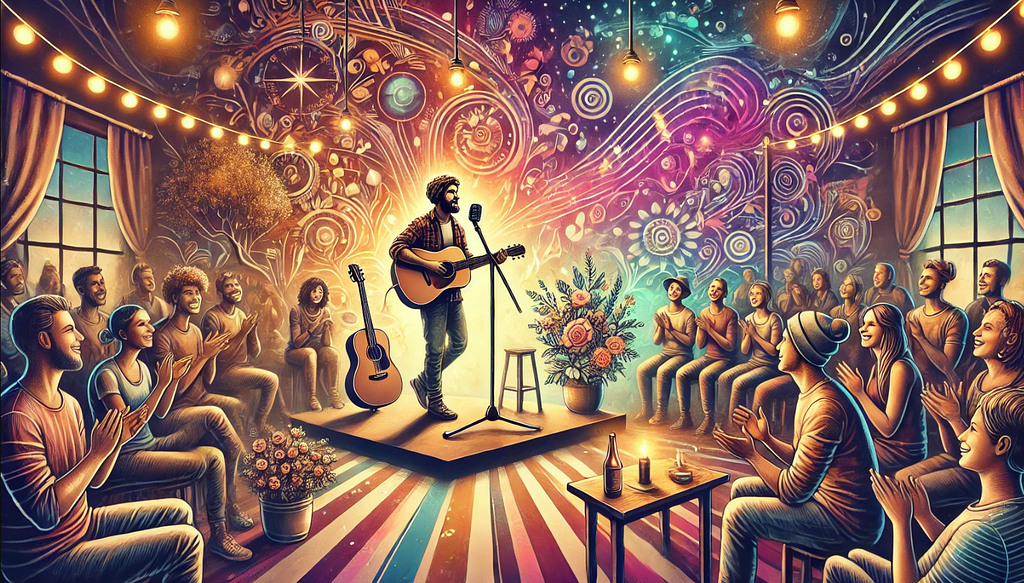Why is it so hard for many musicians and artists to make a decent living? Fundamentally, it has to do with the conflict between the true purpose of the arts and the values of our market-based economic system.
The true purpose of the arts is to provide avenues to beauty, truth, wholeness, and healing. However, the market can’t put a price on any of these things, and so artists are forced to turn our art into a commodity, a stomach-turning conversion which saps our art of its aliveness and transformative potential.
The answer? To align your livelihood with your deepest truths and desires, as opposed to the values of the market. This has the benefit of making your art more inspiring, which, in turn, will boost your bottom line. This video is the first in a series that will give you the philosophical and practical wherewithal to align your livelihood with your Soulforce so that you can achieve what may now seem impossible: the ability to make a profitable, satisfying living as an artist which makes you, your art, and your world more whole and alive.
The “musical chairs” economics video I mention: www.youtube.com/embed/7BZ-WGnZMXM
The “musical chairs” economics video I mention: www.youtube.com/embed/7BZ-WGnZMXM
This video features an excerpt from Chapter 10 “Aligned Livelihood” of my upcoming book. Read the full excerpt from this video below.
Be among the first to know about my upcoming book “Soulforce Arts: The Vital Role of Musicians & Artists in Creating a More Beautiful World” by signing up for my mailing list at JosephArnold.com.
Joseph Arnold Violinist, Alexander Technique Teacher, Director of the Soulforce Arts Institute
For many artists, money and art are unhappy bedfellows. On the one hand, we love being able to make a living from our art because it affords us the time and energy to go deep into our creativity and to share it with others. But on the other, what it takes to make enough money to survive and thrive in our society is so rarely in alignment with our love, authenticity, and creativity. Given this conflict, the choice for many artists can at first seem stark: do you become a “starving artist” and accept penury as the price for artistic purity? Or do you instead choose a life of greater financial stability and risk becoming a sell-out?
At its root, the seeming conflict between art and money is one between the true purpose of the arts and the demands of our economic system. As we’ve already seen throughout this book, the true purpose of the arts is to provide avenues to beauty, aliveness, growth, healing, and wholeness. But our economic system can’t put a price on any of these things, and as a result it demands we turn our art into a commodity, a stomach-turning conversion which effectively saps our art of its full aliveness and transformative potential. Moreover, the artificial scarcity inherent to our society’s economic system makes life like a giant game of musical chairs in which we have to make money constantly or else fall into destitution.[1] Because of the way it so consistently pits our love against our survival, and because we need to survive in order to love, our economic system, to a greater or lesser degree, makes sell-outs of us all.
The terrible choice we face between our love and our survival leads many artists to avoid matters of money, business, and marketing as much as possible. But, of course, this often only makes things worse, because without competency in these areas, you are less equipped to ensure financial success. But this is not the only reason to stop avoiding money, business, and marketing. The deeper truth is that the way you make a living is inexorably tied to how you make art and the impact it ultimately has. Every gig, every sale, and every showcase are actually a part of your system update because, to a certain degree, “the medium is the message.”[2] Therefore, to regard money matters, business, and marketing as inherently distasteful is actually a form of separation, one that has the potential to block the fullest expression of your Soulforce.
The key to resolving the seeming conflict between art and money is to recognize that, just as you can turn your art into an avenue for aliveness, so you can with your livelihood. An aligned livelihood is one that brings more life into the world because it no longer accedes to the deadening effect of the commodification and scarcity endemic to our economic system. Instead, it consists of the choice to stand in your deepest truths, wholeness, and aliveness as you face the significant challenges of surviving and thriving in this system. You will, of course, recognize this as the very definition of Soulforce.
When you align your livelihood with your Soulforce, a whole new world of possibilities opens. Firstly, you will no longer have to compromise your creative wholeness, authenticity, and aliveness in order to survive. Instead, you will be able to engage in money matters, business, and marketing in a way that matches your deepest and highest values. Far from decreasing your economic viability, doing so will only add to the inspirational quality of your art, thus drawing more people to you and enhancing your bottom line. And because your deepest and highest values are very likely already in alignment with the well-being of the world around you, your livelihood will have a net positive effect on our society and planet. This chapter is a guide to aligning your livelihood with your Soulforce so that you can achieve what may now seem impossible: the ability to make a profitable, satisfying living as an artist which makes you, your art, and your world more whole and alive.
One final note. You do not need to be a professional freelance artist to gain benefit from this chapter. Rather, what you will find herein is useful to all artists (and perhaps all people), whether or not you actually earn money from your art. Instead of offering advice specific to certain artistic careers, or to professional artistry in general, this chapter explores a method of aligning your livelihood with your deepest and most authentic desires. And this is something that will enrich and enliven your artistic life, regardless of if you’re a tenured university theater professor, a professional studio musician, or a hobbyist painter.
[1]See this video by Jimi Eisenstein for a brief explanation of the source of scarcity in our economic system. “Our Economic System: A Game of Musical Chairs.” https://www.youtube.com/embed/7BZ-WGnZMXM
[2]McLuhan, Marshall. Understanding Media: The Extensions of Man. 1964.




